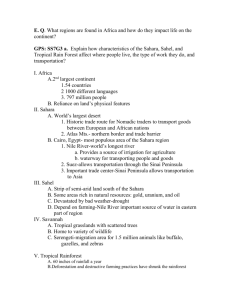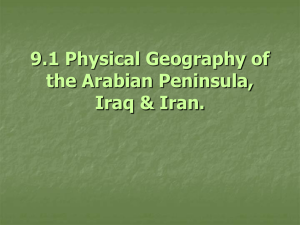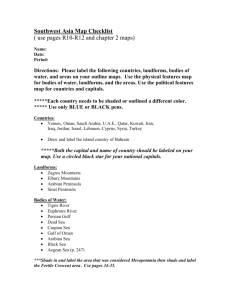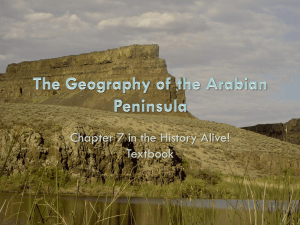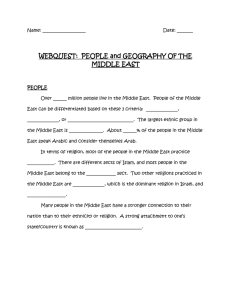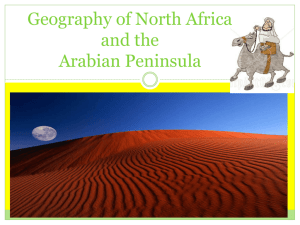North Africa, Southwest Asia & Central Asia
advertisement
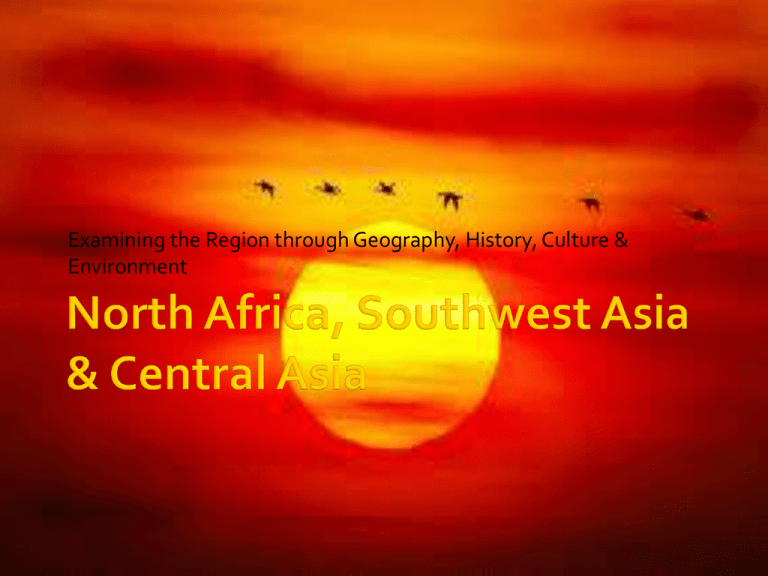
Examining the Region through Geography, History, Culture & Environment Mesopotamia Fertile Crescent Suez Canal Sahel Desertification Desalinization Hieroglyphics Arable Bedouin What factors influence where people live within a certain area? Do you think these factors are the same no matter where you live? What kind of factors would make you move somewhere else? Do you think people move if things change in their physical environment? Migration- Influx of new people. They can bring new beliefs, ideas, practices; immigration vs emigration War- Causes changes in dominating cultures, political systems and institutions Trade- Spreads goods, ideas, beliefs, economics Innovation- Advances in technology can change beliefs/cultural practices Diffusion- Cultural traits spreading from one culture to another; EX- language, religion, customs A number of tools are available for geographers to study settlement patterns. These include: GIS- Geographic Information Systems (a system designed to capture, store, manipulate, analyze, manage, and present all types of geographical data) Maps (atlas) Government data (charts, graphs, reports) Geographic factors, especially the availability of water have determined where people have settled. Disputes have arisen to control water supplies Levels of urbanization have increased. People move from rural areas to cities in order to find employment Some cities have grown so rapidly, supplies and jobs are limited Question: The Middle East and North Africa are examples of what type of regions? A) Formal B) Functional C) Perceptual D) Physical Stretches from Morocco to Kazakhstan Bedouin and nomadic herders Water is the most precious resource Oil is abundant Great early civilizations such as the Egyptians, Sumerians, Persians and Phoenicians. Home to the great three monolithic religions Mediterranean Sea (separates Europe & Africa) Red Sea (located in Saudi Arabia) (separates Arabian Peninsula from Africa) Dead Sea (sits at mouth of Jordan River) Caspian Sea (largest inland body of water on Earth) Aral Sea (East of the Caspian, in the heart of Central Asia) Arabian Peninsula Sinai Peninsula (located east of Egypt) Anatolia (located in Turkey) Map Study Key Places to Locate: • Red Sea • Arabian Peninsula • Persian Gulf • Sinai Peninsula • Anatolia • Nile River • Tigris & Euphrates Rivers • Caspian Sea • Aral Sea The earliest cities have been uncovered in the Tigris and Euphrates River valleys. About 3500 B.C. civilizations began here due to the rich soil created by the rivers. Mesopotamia is the land that is located between the two rivers. Fertile Crescent refers to an area of fertile soil stretching in an arc from the Nile to the Tigris and Euphrates. Nile River Valley The annual flooding of the river brought nutrients to the soil and allowed farmers to grow crops in abundance. Farmers were able to predict the time of the floods and farming became more reliable. People relied less on nomadic ways of life. Farmers learned to retain water for use later in the year by developing an irrigation system. Suez Canal An artificial waterway in Egypt, connecting the Mediterranean Sea and the Red Sea. Opened in November 1869 after 10 years of construction work, it allows transportation by water between Europe and Asia without navigation around Africa The canal is owned and maintained by the Suez Canal Authority (SCA) of Egypt. Under international treaty, it may be used "in time of war as in time of peace, by every vessel of commerce or of war, without distinction of flag. Persian Gulf The Persian Gulf is located between Iran and the Arabian Peninsula. It is an extension of the Indian Ocean. The discovery of oil, transformed the region to one of desolation to one of commercial wealth as the demand for oil globally exploded. Sahara- Once a grassy plain in prehistoric times, the Sahara is now a hot and dry desert located across North Africa. It is the largest desert in the world. Even in the shade, temperatures throughout the day can reach 120F Rub’Al Khali- Also known as the “Empty Quarter” covers the entire southern quarter of the Arabian Peninsula. It has the largest area of sand in the region. Experiences some of the hottest temperatures. The largest desert in the world. It stretches from the Atlantic Ocean to the Red Sea. Temperatures can rise to over 130 degrees. The desert consists of sand, mountains, gravel, and rock formations. Underground water supplies, aquifers can come to the surface. They can create an oasis. In an oasis wildlife and vegetation can survive Sahel means shore of the desert. The Sahel is a narrow band of dry grassland that runs east to west along the edge of the Sahara. It receives very little rainfall. People use the Sahel for farming and herding. The Sahara has spread into the Sahel leading to desertification. Water Resources- rivers, oases, aquifers (underground layer that contains water) Desalinization- Limited freshwater resources have prompted the development of removing salt content from water. Irrigation Man-made river in Libya has pipelines to draw water from aquifers under the Sahara to farms near the Mediterranean Aswan High Dam- located in Egypt; largest man made lake, Nasser Lake Water is critical for life, food production, and industrial processes. 9 of the 14 Southwest Asian states face water shortage conditions. The most concentrated region of water scarcity in the world. The North African states all have rates of natural increase above 2.0%, increasing the stress on water sources. 70% of the world’s known oil reserves and 33% of the world’s known natural gas reserves lie beneath the region. Turkmenistan has the world’s largest deposits of sulfate and sulfur which are used to make glass and detergents. Morocco ranks 3rd in the production of phosphateschemicals used to make fertilizers. Region holds up to 10% or more of world’s iron ore deposits. Other countries such as UAE and Libya are decreasing their reliance on export income and investing in industries such as banking, infrastructure, agriculture and fishing. Black Gold -Oil is vey important. It helps to make everyday items such as crayons, household items and paint. -Arab region contains about 2/3’s of the world’s known petroleum reserves. -Oil profits have turned some countries into gleaming modern cities relatively overnight. -During the 1950’s oil prices were very low resulting in cut payments to some oil producing countries -1960 – Venezuela joins with the four gulf states of Iran, Iraq, Kuwait and Saudi Arabia to form OPEC (Organization of Petroleum Exporting Countries). This organization controls the price of oil as well as its production. Home to the three great monolithic religions- Judaism, Christianity and Islam Jews trace their ancestry to a herder named Abraham who lived in what is now modern day Iraq. Believed God would send a Messiah. Oldest monolithic religion. They worship is synagogues and read the Torah. Officiates are called rabbis. Jerusalem is a holy religious center. Christians believe Jesus to be the Messiah and the Son of God. They assemble in a church and read the Holy Bible. Christians believe in both the New and Old Testaments. Muslims trace their religious origins to the Prophet Muhammad. Believe Jesus to be a great prophet but not the son of God. Today, about 1/5 of the worlds population is Muslim. Their holy book is called the Koran or Q’uran. They assemble in mosques and make yearly pilgrimages to Mecca, Saudi Arabia, a sacred and religious city. Prehistoric peoples of this region were traditionally hunters and gatherers Farmers in this region were among the first to domesticate plants and animals. Area is home to Mesopotamia (land between two rivers) and the Fertile Crescent. Two of the most influential civilizations were the Egyptians and Sumerians who developed forms of writing such as hieroglyphics and cuneiform as well as grand buildings such as pyramids and ziggurats. Arabs- Compromise the majority of the region. Most are followers of Islam and are descendents of ancient Egyptians and Phoenicians. Israelis- Live in Israel. Their religious identity has helped them to keep a link to their homeland. There are constant hostilities between Israel and Arabs/Palestinians over land control (West Bank and Gaza Strip) Turks- People who live in Turkey or Anatolia. Turkic people migrated to the peninsula around the AD 1000’s from Central Asia. Ottoman Turks were responsible for building up the Ottoman Empire. Most practice Islam and blend their culture with Turkish, Islamic and Western elements. Iranians and Afghanis- Iran once called Persia is home to about 66 million people. They are descendents of the Indo-European Aryans who migrated from southern Russia about 1000 BC. The predominate language is Farsi mixed with other ethnic languages. Caucasian- Consists of Armenians and Georgians. Both Armenia and The Republic of Georgia became independent after the fall of the Soviet Union in 1991. They also make up some of the largest ethnic groups. Turkic- Peoples living outside of Turkey which consists of the Uzbeks and Kazakhs. Most live in the republics of Central Asia and are Muslim. Uzbeks make up the largest Turkic group, while Kazakhs are minorities in their own country of Kazakhstan. Kurds- Live in areas of Turkey, Iraq, Iran and Syria. They speak Farsi. They do not have their own land and any efforts to win self rule have been repeatedly crushed by Turkish and Arab rulers. Agriculture- only a small part of the region’s land is arable (suitable for farming). Many people including bedouins herd animals such as sheep and goats. Countries closer to the Mediterranean yield fruits, olives, dates and cereals. Fishing- sardines, mackerel and other aquatic exports Oil, Natural Gas and Mining- petrochemicals, coal, copper and phosphates Service- banking, real estate, insurance/investments, tourism Transportation/Communication- infrastructure, transit systems, air traffic systems, and expanding wireless and cell phone industry, satellites, cybercities Arab-Israeli Conflict: Israel was founded as a Jewish state after WWII in 1948. From the beginning of time Jews and Palestinians have had disputes and disagreements about land settlements, borders/boundaries and religion. Palestinians want their own homeland and continue to seek statehood. They would like to house their independence in the West Bank and the Gaza Strip; both Israeli occupied. Throughout the years, both sides have tried to come together and compromise on a peace settlement, but to no avail. Wars in Afghanistan: During the later years of Communism, Russia tried to exert their influence and establish Communistic spheres in Afghanistan. Freedom fighters known as mujahedeen combated the Communists with the aid of the US and Pakistan. Since 2001 and the terrorism of 9/11, the US and its allies have been a military presence in the region to combat the Taliban. Persian Gulf War of 1991, Sadaam Hussein invaded Kuwait, killings Kurds. The US and its allies forced him to withdraw. Traditionally, the region had been ruled under royal dynasties, but in modern times, the region shares different types of government: -Monarchy: Saudi Arabia, UAE, Morocco and Jordan -Parliamentary Democracy: Israel (president is head of state and prime minister is head of the government) -Republic: Ruling presidents in Egypt, Syria, Kazakhstan, Georgia - Military based Dictatorship: Libya under Ghadaffi and Iraq under Sadaam Hussein Sadaam Hussein of Iraq Ghadaffi of Libya All three religions have their unique observances… Islam- pray 5x a day towards Mecca, Feast of Sacrifice and Ramadan Judaism-Yom Kippur is a time for feasting and fasting, Passover and Hanukkah Christianity- Christmas and Easter

